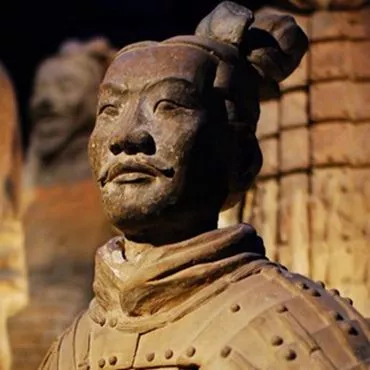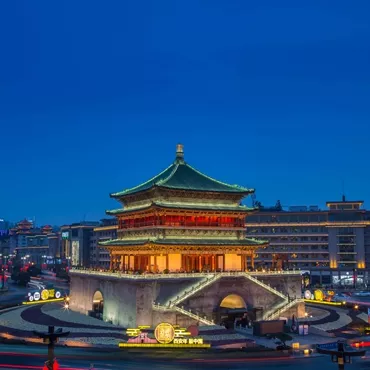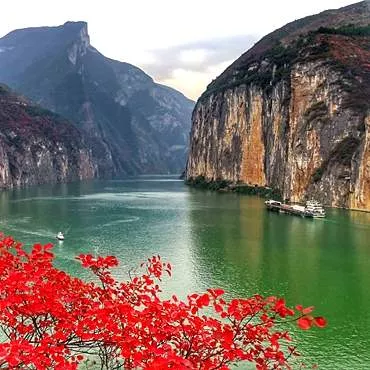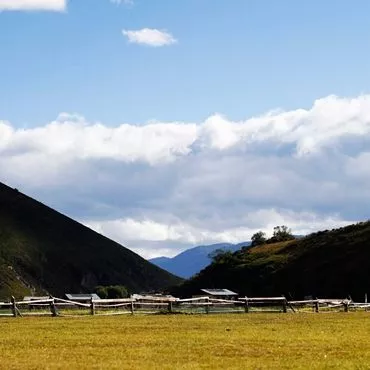Qian Mausoleum
Qian Mausoleum is one of the Tang Dynasty's eighteen imperial mausoleums located in the northern part of Qian County, Xianyang City, Shaanxi Province, about 6 kilometers from the county seat on Liangshan Hill. It serves as the joint burial site of Emperor Gaozong of Tang and Empress Wu Zetian. The mausoleum is vast, covering an area of "eighty li" (approximately 40 kilometers) in circumference. It features inner and outer walls; the inner city walls are 1,450 meters long north-south, with the east wall at 1,583 meters and the west wall at 1,438 meters, totaling nearly 2.4 million square meters.
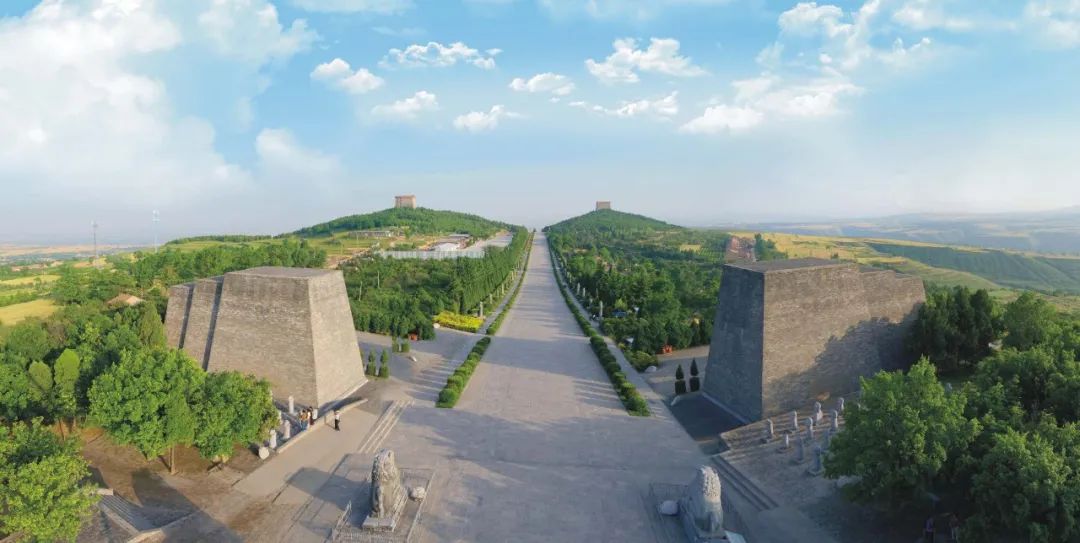
Construction of Qian Mausoleum began in the first year of the Tang Guangzhai era (684 AD) and was expanded in the second year of the Shengong era (706 AD). The mausoleum follows the "mountain-shaped tomb" construction method, modeled after the layout of Chang'an, the Tang capital. Apart from the main tomb, Qian Mausoleum includes seventeen smaller satellite tombs, where other members of the imperial family and honored officials were laid to rest. Qian Mausoleum boasts the best-preserved main tomb among the Tang Dynasty's eighteen mausoleums and is the only one not to have been plundered. On March 4, 1961, Qian Mausoleum was designated by the State Council as one of the first national key cultural heritage sites.
The Main Mausoleum
During the prosperous Tang era, Qian Mausoleum was constructed on a grand scale, combining majestic architecture with elaborate carvings. Emperor Taizong of Tang pioneered the "mountain-shaped tomb" design, with buildings and sculptures arranged among the peaks like dragons and phoenixes. Qian Mausoleum further developed and refined the layout of the Zhao Mausoleum, mirroring the layout of Chang'an, divided into the Imperial City, Palace City, and Outer City, with a main axis stretching 4.9 kilometers north-south. Historical records describe Qian Mausoleum as encompassing "eighty li" in circumference, originally fortified by double walls. The inner city, approximately square-shaped, has walls 1,450 meters long north-south, 1,582 meters east, and 1,438 meters west, covering about 2.3 million square meters. Within the city are splendid buildings including a Hall of Offerings, annexes, corridors, archways, and shrines to 60 courtiers like Di Renjie, as well as lower palaces and other magnificent architectural complexes.
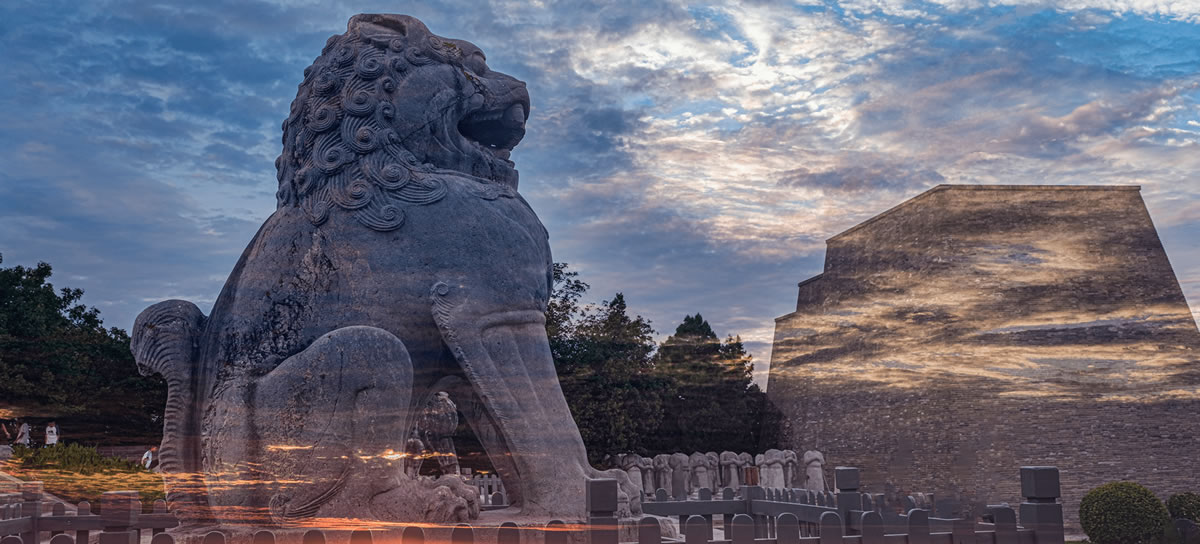
The Underground Palace
According to surveys of the Qian Mausoleum underground palace conducted by Xi'an Cultural Relics Protection Center, experts combined with the Qian Mausoleum satellite tomb excavations and related literature to estimate that the tomb consists of a tomb passage, a crossing hole, a skywell, a corridor, and three main tomb chambers, possibly including an ear chamber. A coffin bed was set up in the central chamber to hold the emperor's "tomb," a coffin, with the lower part of the tomb covered with moisture and wood rot-resistant materials, and treasures, and "seven-star boards" were also placed above it. The boards were placed with clothing, and the sides placed jade ritual vessels.
The Shusheng Stele
The Shusheng Stele, situated to the west of Sima Road opposite the Wordless Stele, stands as a testament authored by Empress Wu Zetian herself and inscribed by her son, Emperor Zhongzong of Tang, extolling the virtues and achievements of Emperor Gaozong. This monumental testament marks a pioneering example of commemorating imperial achievements before burial, breaking with the tradition of no steles or epitaphs inside imperial tombs before Qian Mausoleum. Therefore, the Shusheng Stele holds profound historical significance.
Standing at 7.53 meters tall and 1.86 meters wide on each side, weighing approximately 89.6 tons, the stele is crowned with a palace-style roof adorned with four guardian figures at the corners. The body of the stele consists of five sections seamlessly joined together with complete blue stone mortise and tenon joints. Below, the base is similarly constructed and decorated with motifs of xiezhi and pomegranate. Comprising seven parts in total—roof, body, and base—the stele symbolizes the sun on its top and the moon on its base, while the five middle sections represent the elements of metal, wood, water, fire, and earth. Ancients believed that all things in the universe are composed of these seven elements, thus earning the stele the nickname "Seven-section Stele," symbolizing how Emperor Gaozong's governance and military achievements illuminate the world like the sun, moon, stars, and constellations, radiating throughout the ages.
The entire text of the Shusheng Stele, engraved in regular script across its front and the east and west sides of the five sections, spans 46 lines and over 5600 characters. Due to centuries of weathering and deliberate damage, only about 1600 characters remain visible today. Historical records indicate that each character was originally filled with gold dust, giving the stele a shimmering appearance and earning it the nickname "Golden Stele." Initially, the stele was housed in a pavilion whose foundation measured 18.80 meters north-south and 18.85 meters east-west, although the pavilion itself has long since vanished.
Wordless Stele
To the east of Sima Road outside the Vermilion Bird Gate stands the renowned Wordless Stele, hewn from a single massive stone block measuring 7.53 meters in height, 2.1 meters in width, and 1.49 meters in thickness, with a total weight of 98.8 tons, imparting a sense of solidity and seamless unity. The stele remains unmarked on its face, featuring a central coiled dragon flanked by nine such dragons, hence its moniker "Nine Dragons Stele." Both sides of the stele bear relief carvings depicting dragons soaring through the sky, vividly brought to life. On the sunny side of the base, a depiction of a lion-horse duel (or lion-horse confrontation) is skillfully etched, measuring 2.14 meters in length and 0.66 meters in width, with the horse bending its hooves and lowering its head, while the lion lifts its head in a fierce gaze. The stele also features numerous floral and leaf patterns, showcasing fine and smooth lines.
Facing the west of the Shusheng Stele, flanked to the north by the Eastern Gate and to the south by Wengzhong, the Wordless Stele stands grand and splendid, its exquisite carvings making it the crown jewel among steles of all ages. Starting from the Song and Jin dynasties, visitors began inscribing the stele with their own words, transforming it into a stele with inscriptions. Throughout subsequent Yuan, Ming, and Qing dynasties, many texts were gradually engraved on the stele, not only naturally forming a "textual monument" evaluating Empress Wu Zetian but also exhibiting versatility in calligraphic styles such as regular, cursive, clerical, seal, and running scripts. Perhaps this very aspect aligns with Empress Wu Zetian's original intent in erecting the stele. Among them, the complete "Memorial of the Great Jin Imperial Prince and the Supreme Commander" written in Jurchen in 1135 and accompanied by a Han translation remains valuable for studying Jurchen script and the historical culture of Chinese minorities.
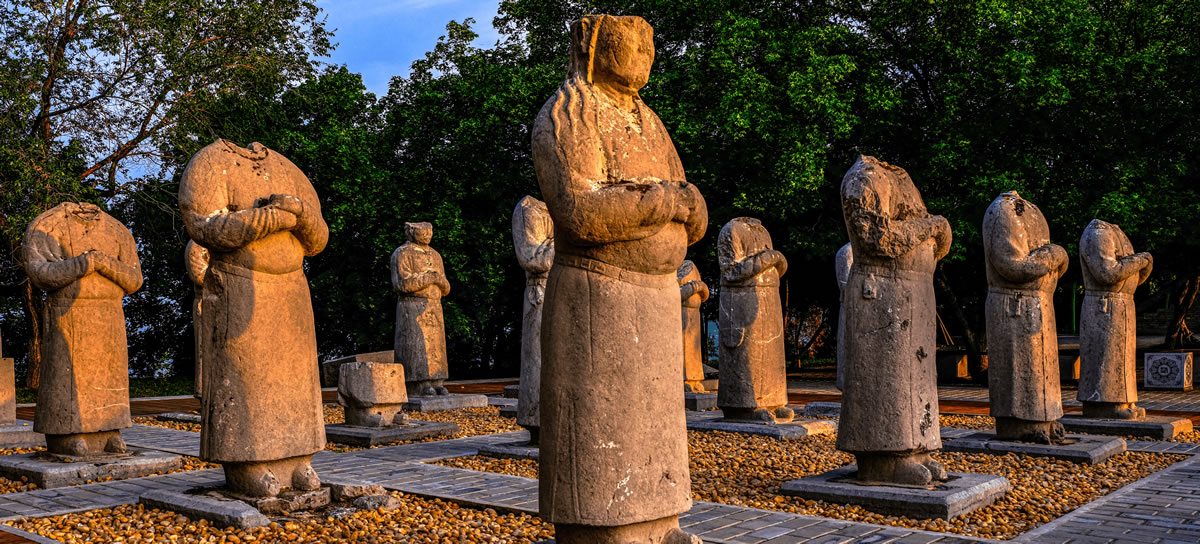
The Headless Stone Statues
Outside the Vermilion Bird Gate of Qian Mausoleum's Sacred Way, on both sides, stand stone statues without heads, their origins shrouded in various speculations. Folklore suggests that during the early Ming Dynasty, these statues' heads were allegedly chopped off by local peasants. The tale goes that a foreign envoy visiting Qian Mausoleum was dismayed to find his ancestors standing guard over Tang Dynasty emperors' tombs, feeling it undermined his nation's dignity and insulted his own. His wounded pride led him to contemplate destroying the statues but fearing local backlash, he devised a clever scheme. Each night, he would trample the crops near Qian Mausoleum and the next day, he'd fan the flames, blaming the statues for their nocturnal mischief, claiming they'd become malevolent spirits ruining the crops. To protect the harvest, the enraged locals then destroyed the statues' heads in agreement with the envoy's rationale.
Historical and Cultural Value
Qian Mausoleum's significance transcends being the unique joint burial site of two generations of Tang Dynasty imperial couples; it embodies a quintessential relic of the flourishing Tang culture, offering invaluable material for studying Tang history, culture, and art.
Firstly, Qian Mausoleum's importance stems from its distinctive historical status. Serving as the final resting place for Emperor Gaozong of Tang, Li Zhi, and Empress Wu Zetian, Qian Mausoleum epitomizes the transition of the Tang Dynasty from prosperity to decline. These two monarchs played pivotal roles in Tang history, their reigns marking the peak of Tang culture and national power. Thus, Qian Mausoleum not only serves as their eternal sanctuary but also encapsulates a microcosm of Tang Dynasty history.
In terms of cultural and artistic significance, Qian Mausoleum's value is immeasurable. Its ground structures, stone carvings, and murals vividly showcase the unique charm of Tang culture. For instance, the stone carving art at Qian Mausoleum, with its exquisite craftsmanship and expressive power, vividly illustrates the splendor and grandeur of the Tang Dynasty. The murals, with their delicate strokes and rich content, provide a window into Tang social life and cultural arts.
Moreover, Qian Mausoleum represents a crucial academic resource for studying Tang history and culture. Through archaeological excavations and research, scholars gain deep insights into Tang political systems, social structures, religious beliefs, and customs. This wealth of information not only enhances our understanding of the Tang Dynasty but also offers valuable insights into the development of human societies.
Lastly, as an invaluable cultural heritage site, Qian Mausoleum holds irreplaceable educational and tourist value. Visitors to Qian Mausoleum can personally experience the allure of Tang culture, fostering a stronger sense of identity and pride in Chinese historical and cultural heritage. Concurrently, Qian Mausoleum's development has spurred local tourism and related industries, contributing positively to the economic and social progress of the region.

